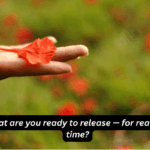Understand them. Regulate them. Heal through them.
We’ve all been there.
You’re having a decent day, and then — boom.
Someone says something, a memory flashes, a tone shifts, a text hits wrong…
And suddenly, you’re spiraling. Shutting down. Angry. Numb. Defending yourself to someone who isn’t even there.
This is the work of an emotional trigger.
But here’s the beautiful part:
Your triggers aren’t enemies.
They’re messengers.
They’re unhealed wounds asking, “Hey… can we talk?”
In this guide, we’re going to explore what emotional triggers are, why they happen, and — most importantly — how to deal with them in a way that supports your healing, not your self-blame.
What Is an Emotional Trigger?
An emotional trigger is anything — a word, situation, tone, person, or event — that causes a strong emotional reaction in you, often disproportionate to the moment.
It’s not about being “overly sensitive.”
It’s your nervous system responding to something unresolved.
Think of it like this:
A trigger is a signpost pointing toward something you’ve buried, minimized, or didn’t know still needed healing.
Common Emotional Triggers
These are personal, but some common examples include:
- Feeling dismissed or ignored
- Being criticized or corrected
- Being excluded or left out
- Rejection or abandonment (even perceived)
- Disrespect or being talked down to
- Someone not texting back “fast enough”
- Conflict or confrontation
- Being told you’re “too much” or “too emotional”
The emotional reaction isn’t just about what happened — it’s about what it represents.
See our Emotional Triggers Library for more details about the most common triggers.
What’s Actually Happening in Your Brain and Body
Your brain doesn’t know the difference between past pain and present discomfort.
When something reminds it of a previous threat (even emotional), it activates your fight, flight, freeze, or fawn response.
That’s why your heart races, your chest tightens, your thoughts spiral, and your ability to “think logically” disappears.
This isn’t weakness. It’s neurobiology.
And the more compassion you bring to your triggered moments, the more access you’ll have to self-regulation.
Step-by-Step: How to Deal with Emotional Triggers
1. Pause Before Reacting
This one’s hard — but vital.
The moment you feel activated, pause. Literally stop what you’re doing if you can.
Ask:
“Is this reaction about now… or is this old pain showing up again?”
This moment of space interrupts the autopilot reaction.
2. Name What’s Happening
Say it out loud or journal it:
“I feel triggered because…”
“This is reminding me of when…”
“I know this reaction is stronger than the situation, and that’s okay.”
Naming the emotion gives you power over it.
3. Locate It in Your Body
Where are you feeling it — chest, throat, stomach?
Put your hand there. Breathe into it.
This simple act of somatic awareness calms your nervous system faster than thoughts ever can.
4. Offer Compassion Instead of Shame
Don’t berate yourself for being “too emotional.”
Try this instead:
“Of course I feel this way. This is tender. I’m allowed to feel, and I’m learning how to hold myself through it.”
Shame locks the wound in place.
Compassion creates space for healing.
Many emotional triggers are rooted in early experiences — healing your inner child can help you address those deeper wounds with compassion.”
5. Respond (Not React)
Once the emotional intensity softens, choose your response intentionally:
- Do I need to set a boundary?
- Do I need a break or support?
- Is there something I need to communicate — or just witness?
Responding from regulation is always more powerful than reacting from pain.
If you need simple ways to calm your body when a trigger hits, try these self-soothing practices for overwhelm to gently regulate your nervous system in the moment.
Emotional Regulation Tools to Practice Regularly
Even when you’re not triggered, practicing these helps build emotional resilience:
- Breathwork or grounding techniques
- Self-inquiry journaling (e.g., “What’s underneath this feeling?”)
- Inner child check-ins
- Somatic movement (like shaking, stretching, or walking mindfully)
- Tapping/EFT for emotional release
- Creating a ‘trigger care plan’ in advance (what soothes you, what escalates you)
The goal isn’t to eliminate triggers — it’s to transform your relationship with them. If your emotional triggers feel heavy and persistent, it may be time to explore the deeper weight behind them — this guide on letting go of emotional baggage offers a gentle path to release.
A Note on Healing Triggers in Relationships
When someone else triggers you, it doesn’t mean they’re wrong.
And when you trigger someone, it doesn’t mean you’re toxic.
It means something tender has been touched.
Healing can happen individually, and relationally — if safety, consent, and mutual respect exist.
Communicate what you’re learning. Let others know when you’re tender. Ask for what you need. Own your process — with softness.
Reframing Triggers as Teachers
Your triggers aren’t here to destroy your peace.
They’re here to show you where your soul still needs tending.
They’re old wounds looking for new outcomes.
And every time you meet them with awareness instead of avoidance — you grow.
So next time your chest tightens, your thoughts race, or your tears come fast…
Pause.
Breathe.
Name it.
Hold yourself.
Choose differently.
That’s emotional regulation. That’s nervous system healing.
That’s coming home to yourself in real-time.
Final Thoughts
You are not “too much.”
You are not broken.
You are not dramatic.
You are a complex, feeling, healing human being — and your triggers are not evidence of failure.
They are invitations into deeper self-awareness, deeper compassion, and deeper freedom.
Every time you meet your reaction with care instead of criticism,
you take back your power.
You choose the present over the past.
And that? That’s emotional self-mastery.



